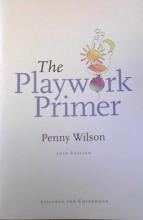
Professional playworker Penny Wilson has communicated the essence of the British playwork movement through The Playwork Primer, a 40 page booklet published by the Alliance for Childhood in 2010. Through a clear overview, a concise history, and definitions of terms she has endeavored to introduce playwork and the adventure playground concepts to the American play industry.
Penny begins by quoting Arthur Battram, “Through play we become human,” and then declares that it is through play that our adult worlds are shaped; therefore, “real playing is almost the most important thing that our children can do.”1 She maintains that when children control the content and intent of their play, they develop neural capacities as they “integrate their internal and external worlds.”2 As such, play becomes a growth process and not an end product.
Play, which is a universal language of children, is defined as “a set of behaviors that are freely chosen, personally directed, and intrinsically motivated.”3 An adventure playground furthers this kind of play as it is designed to be “in a constant process of change, directed, informed, and executed by the children and their playing and supported by the playworkers.”4 They are a psychological safe place where children can take calculated risks as they explore different kinds of play. In this process, Stuart Lester asserts that “they can learn – in the widest possible sense – about themselves, about others, and about the world.”5
Hoping to solve an increasing child delinquency problem under German occupation during World War II, Danish leaders commissioned the architect Carl Theodor Sorensen to create a place for children to play. Sorensen had already designed playgrounds in Copenhagen-Emdrup, but was surprised to find them empty. Instead he found the children playing in bombed out buildings. The children's preference in play led Sorensen in 1943 to design “junk” playgrounds which included unstructured areas to explore and materials the children could manipulate.
In 1946 after the war, Lady Allen of Hurtwood visited this junk playground and realized that she was observing “something quite new and full of possibilities.”6 She brought the concept to London where children were also playing in bombing ruins and named the resulting play areas “adventure playgrounds.”
These London bomb site playgrounds were supervised by “wardens” who unlocked the tool sheds that held the building materials and tools for play. As the wardens observed the children, they became impressed with the value of play and became advocates for adventure playgrounds. They gathered more play materials, encouraged local support, exchanged information among themselves, and wrote of their experiences.
The wardens evolved first into “play leaders” and then into “playworkers” since they don't lead the play but “work with the play” of the children. These professional playworkers seek to be “invisible and unobtrusive” leaving “the children free to play for themselves but intervening in carefully measured ways to support the play process.”7
The balance of The Playwork Primer involves the philosophy and tools of playwork explained through definitions. This includes the 8 key “Playwork Principles,” Bob Hughes' 16 “Play Types,” the good and the bad of “Play Rules,” Elizabeth Goodenough's “Secret Spaces,” and “Inclusive Play,” a “fight against apartheid in play.”8
One of the philosophies included are the beliefs of D. W. Winnicott, a pediatrician and psychologist, who outlines the stages of a mother-child relationship as progressing from absolute dependence, to relative dependence, to independence.9 These stages correspond with play behaviors. D. W. Winnicott promoted the “Mirroring” technique also defined in The Playwork Primer.
Another theory included is “Complexity,” a way of understanding natural systems. For example, by exploring the complexity of a wave, Arthur Battram uses the image of “surfing on the edge of chaos and order as a metaphor for how a play setting works.”10
Detrimental concepts explored include the “Commodification of play” which gives the message to children that the only “valid play experiences are bought experiences.”11 Such experiences involve electronic and other toys, special parties, movies and videos, clubs, classes, and adult organized outings. In a similar vein, the “Trivialization of play,” “Spaces of Exclusion,” “Mollycoddling,” and “Play Deprivation” are also explained and warned against.
Some of the tools of playwork which are defined include “Loose Parts,” “Cardboard Boxes,” “Liminal Spaces,” “Quirkiness,” “Invisibility,” and “Stories,” a child-like way to represent play. In “Recalcitrance,” Penny defines the optimal playworker as a “nonconformist, seeing the world outside the box, being offbeat and unconstrained in their creativity, lateral thinkers, able to tolerate with joy the benign wildness of creativity that they observe in the playing child.”12
Additionally, children's inherit natures of “Neophilia,” the love of the new, and “Biophilia,” the love of the living world, are explored as well as “Biophobia,” the fear of nature. Penny acknowledges the work of Richard Louv through his book, Last Child in the Woods, and his leadership in the Children & Nature Network, in addressing the need to build on children's biophilia and to mitigate our cultural messages of biophobia.
The Playwork Primer concludes with a listing of resources concerning Playwork, Play, and Creating Playgrounds, specifically adventure playgrounds.
- 1. Wilson, Penny. The Playwork Primer. College Park, MD: Alliance for Childhood, 2010. p. 5.
- 2. Ibid., p. 6.
- 3. Op.cit., Wilson. p. 5.
- 4. Op.cit., Wilson. p. 7.
- 5. Op.cit., Wilson. p. 5.
- 6. Op.cit., Wilson. p. 7.
- 7. Op.cit., Wilson. p. 8.
- 8. Op.cit., Wilson. p. 15.
- 9. Op.cit., Wilson. p. 33-35.
- 10. Op.cit., Wilson. p. 12-13.
- 11. Op.cit., Wilson. p. 11-12.
- 12. Op.cit., Wilson. p. 26-27.

